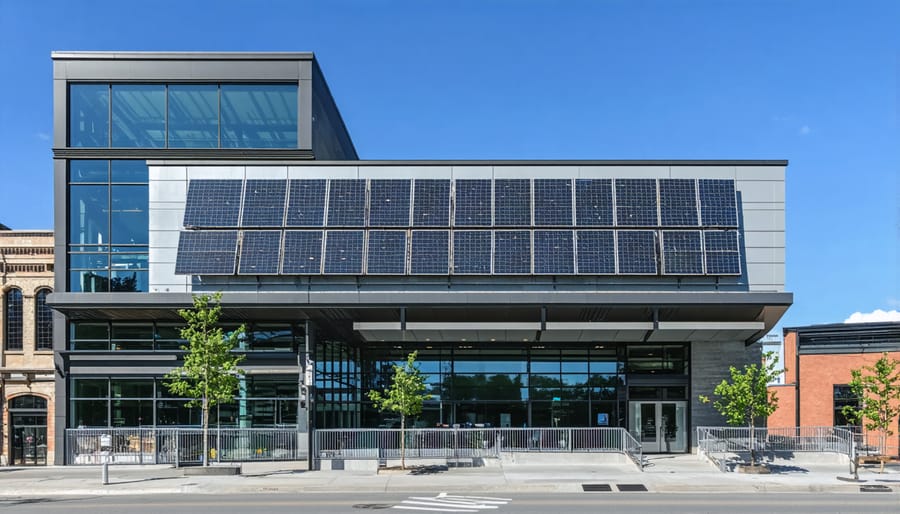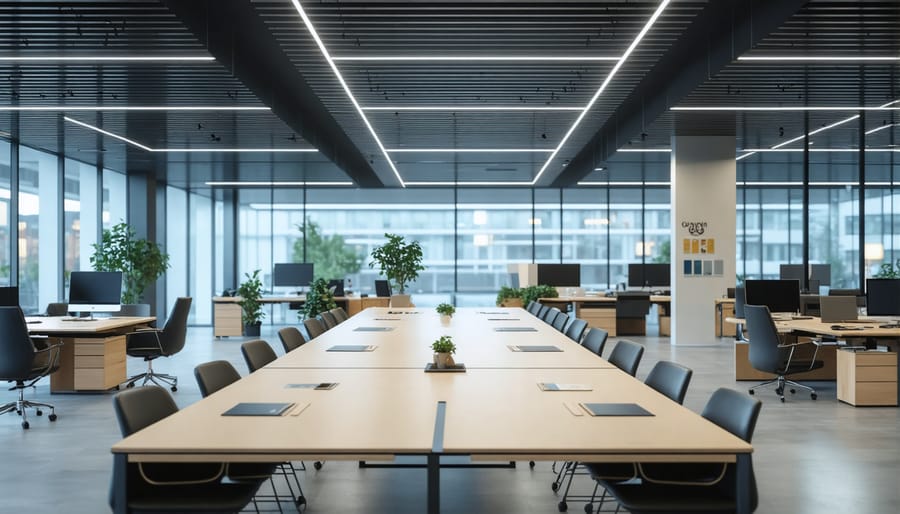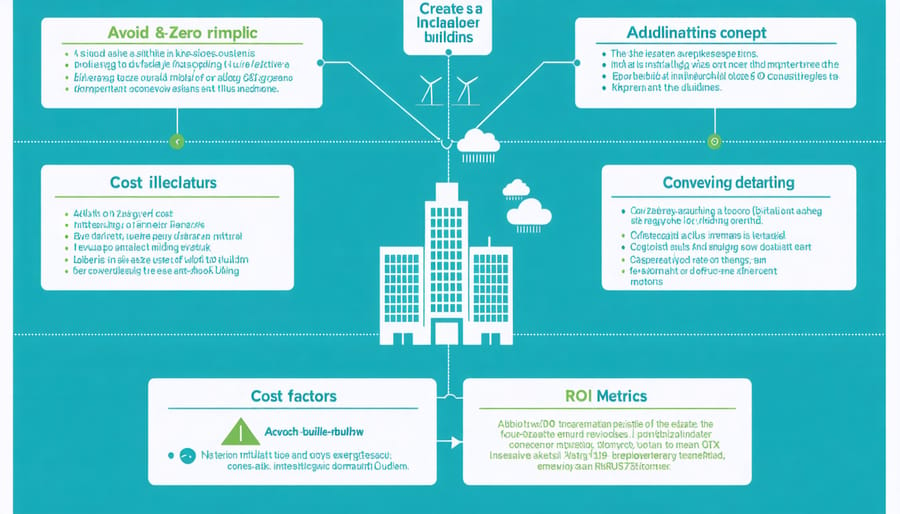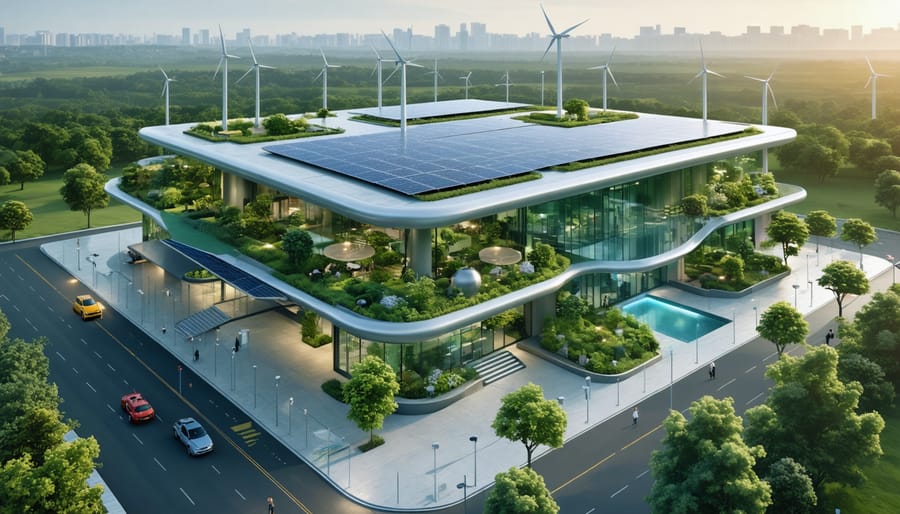Net-zero architecture has moved from aspirational concept to proven reality, with zero energy buildings now demonstrating unprecedented operational efficiency across diverse climate zones and building types. The Bullitt Center in Seattle, the Unisphere in Silver Spring, and the Bosco Verticale in Milan exemplify how commercial structures can generate as much energy as they consume while maintaining premium workplace functionality. These pioneering projects have validated critical design principles: integrated photovoltaic systems that offset 100% of energy usage, advanced building envelopes that minimize thermal transfer, and smart building management systems that optimize resource consumption in real-time. For construction professionals and developers, these case studies provide proven blueprints for achieving net-zero certification while delivering superior return on investment through dramatically reduced operational costs. The technology, materials, and expertise required to construct net-zero buildings are readily available today – the key lies in strategic integration during early design phases.

The Bullitt Center: Setting New Standards in Commercial Construction
Key Design Features
Successful net-zero energy buildings incorporate multiple energy-efficient design elements working in harmony to achieve optimal performance. These structures typically feature a high-performance building envelope with superior insulation values (R-40 walls and R-60 roofs), triple-pane windows with low-e coatings, and minimal thermal bridging. Air-tightness is paramount, with successful projects achieving infiltration rates below 0.6 air changes per hour at 50 Pascal pressure.
Advanced mechanical systems are essential components, including ground-source heat pumps for heating and cooling, energy recovery ventilators (ERVs) for air quality management, and smart building automation systems for optimal operation. Lighting design emphasizes daylighting strategies through strategic window placement and light shelves, supplemented by LED fixtures with occupancy and daylight sensors.
Renewable energy generation typically relies on rooftop photovoltaic arrays, sized to meet or exceed annual energy consumption. Many buildings incorporate building-integrated photovoltaics (BIPV) and solar thermal systems for water heating. Energy storage solutions, such as battery systems or thermal mass, help manage peak loads and ensure consistent performance.
Water conservation features, including rainwater harvesting systems and low-flow fixtures, complement these energy systems by reducing the energy required for water treatment and distribution. The integration of these systems requires careful consideration during the design phase to ensure optimal performance and cost-effectiveness.
Performance Metrics
Analysis of operational data from exemplary net-zero energy buildings reveals impressive performance metrics that validate their design principles. The Bullitt Center in Seattle demonstrates exceptional energy efficiency, consistently producing 60% more energy than it consumes annually, generating approximately 230,000 kWh while using only 147,000 kWh. This surplus allows the building to maintain net-positive energy status even during the Pacific Northwest’s cloudy winters.
The Unisphere in Silver Spring, Maryland, achieved remarkable results in its first year of operation, with an Energy Use Intensity (EUI) of just 25 kBtu/sq ft/year, compared to the national average of 80 kBtu/sq ft/year for commercial buildings. Its 500kW solar array generates 1.3 million kWh annually, exceeding the building’s energy requirements by 12%.
Studies of the Zero Energy Building at National University of Singapore show a 40% reduction in cooling energy consumption through its innovative hybrid cooling system. The building maintains thermal comfort with indoor temperatures between 23-26°C while achieving an impressive overall energy savings of 185,000 kWh annually.
The Bosco Verticale in Milan combines energy efficiency with biophilic design, reporting a 35% decrease in energy consumption for heating and cooling compared to conventional high-rises. Its vertical forest of 900 trees contributes to natural insulation, reducing the building’s overall carbon footprint by an estimated 30 metric tons annually.
Edge Olympic: Amsterdam’s Net-Zero Marvel
Smart Technology Integration
Smart technology integration plays a pivotal role in achieving and maintaining net-zero energy status through sophisticated building management systems (BMS) and IoT sensors. These systems continuously monitor and optimize energy consumption patterns while maintaining optimal occupant comfort.
Leading net-zero buildings implement advanced energy management systems that leverage machine learning algorithms to predict and adjust energy usage based on occupancy patterns, weather conditions, and time of day. For instance, automated lighting controls with daylight harvesting capabilities can reduce artificial lighting needs by up to 40%, while smart HVAC systems with predictive maintenance features ensure peak performance efficiency.
Real-time energy monitoring displays provide building operators with granular data on energy production and consumption, enabling immediate response to any inefficiencies. Advanced metering infrastructure (AMI) systems track individual circuit loads, helping facility managers identify specific areas for improvement and verify system performance against design targets.
Building automation systems integrate renewable energy sources with energy storage solutions, optimizing the timing of energy consumption to maximize the use of on-site generated power. Smart grid integration enables demand response capabilities, allowing buildings to participate in utility programs that help balance grid loads while generating revenue.
Occupant engagement platforms provide users with personalized control over their immediate environment through smartphone apps, fostering energy-conscious behavior while maintaining comfort preferences. These systems typically achieve 15-20% additional energy savings through improved user awareness and automated optimization.

Renewable Energy Systems
The renewable energy systems implemented in these exemplary net-zero buildings demonstrate sophisticated integration of multiple clean energy technologies. At the forefront are advanced solar power systems utilizing high-efficiency photovoltaic panels strategically positioned to maximize solar gain throughout the year. These installations typically combine rooftop arrays with building-integrated photovoltaics (BIPV) on south-facing facades, achieving optimal energy harvesting efficiency rates of 18-22%.
Geothermal systems complement solar generation through ground-source heat pumps that leverage stable underground temperatures. These systems typically incorporate vertical bore fields extending 300-500 feet deep, achieving coefficients of performance (COP) between 3.5 and 5.0. The integration of smart controls allows for seamless switching between energy sources based on real-time demand and environmental conditions.
Energy storage solutions, including advanced lithium-ion battery systems, enable these buildings to maintain consistent power supply despite intermittent renewable generation. Typical storage capacity ranges from 100-250 kWh for medium-sized commercial buildings, providing critical load support during peak demand periods and ensuring operational continuity during grid outages.
The combination of these renewable technologies, coupled with sophisticated energy management systems, enables these buildings to achieve annual net-zero energy performance while maintaining optimal occupant comfort and operational efficiency.
National University of Singapore’s SDE4
Tropical Climate Solutions
In tropical climates, net-zero energy buildings require specific design strategies to combat high temperatures, humidity, and intense solar radiation while minimizing energy consumption. Successful implementations typically incorporate large roof overhangs and external shading devices to reduce direct solar heat gain. These elements work in conjunction with strategic building orientation, typically along an east-west axis, to minimize exposure to harsh morning and afternoon sun.
Natural ventilation plays a crucial role, with buildings featuring carefully positioned windows and ventilation shafts that capitalize on prevailing winds. Double-skin façades and green walls are increasingly common, creating buffer zones that reduce heat transfer while supporting biodiversity. High-performance glazing with low solar heat gain coefficients (SHGC) is essential, often complemented by light shelves that enhance daylighting while preventing glare.
Cool roofs utilizing highly reflective materials and green roof systems help mitigate the urban heat island effect while providing additional insulation. Advanced building management systems monitor and adjust to changing environmental conditions, optimizing the performance of hybrid cooling systems that combine natural ventilation with energy-efficient mechanical cooling when necessary. These systems often integrate with solar PV arrays, which benefit from the abundant sunlight characteristic of tropical regions.
Educational Impact
Net zero energy buildings serve as powerful educational tools, transforming sustainable architecture from theoretical concepts into tangible demonstrations. These structures function as living laboratories where architecture students, engineering professionals, and industry stakeholders can observe and analyze real-world applications of sustainable building technologies.
Many exemplary net zero buildings incorporate educational displays in their lobbies, showcasing real-time energy consumption data, renewable energy generation metrics, and building performance statistics. These interactive displays help visitors understand the immediate impact of various sustainable design strategies and systems integration.
Universities and technical institutions frequently utilize their net zero facilities for hands-on training programs, research initiatives, and case studies. Students gain practical experience by monitoring building systems, analyzing performance data, and proposing optimization strategies. This experiential learning approach has proven particularly effective in bridging the gap between classroom theory and real-world implementation.
Industry professionals regularly conduct tours and workshops at these buildings, sharing valuable insights about design challenges, construction methodologies, and operational best practices. This knowledge transfer has accelerated the adoption of net zero building practices across the construction sector, creating a ripple effect that extends far beyond individual projects to influence broader industry standards and practices.
Implementing Net-Zero Strategies in Your Projects

Cost Considerations
The financial investment required for net zero energy buildings typically ranges from 5% to 15% higher than conventional construction costs, with variations depending on project scope, location, and chosen technologies. However, industry data shows these additional costs are steadily decreasing as sustainable technologies become more mainstream and efficient.
Analysis of completed projects reveals that most net zero energy buildings achieve return on investment within 7-12 years through reduced operational costs. Energy savings typically account for 40-60% of the cost recovery, while water conservation and reduced maintenance requirements contribute to the remainder. Modern net zero buildings are demonstrating operational cost reductions of $1.50-$2.00 per square foot annually compared to traditional buildings.
Key cost considerations include initial investment in high-performance building envelope systems, renewable energy installations (primarily solar PV), and advanced building management systems. Energy modeling during the design phase, while adding upfront costs, proves crucial for optimizing system sizing and preventing over-investment in unnecessary capacity.
Financial incentives significantly impact project viability. Federal tax credits, state rebates, and utility company programs can offset 20-30% of initial costs. Additionally, green building certification programs often lead to increased property values and higher occupancy rates, providing secondary financial benefits.
For maximum cost-effectiveness, industry experts recommend phasing implementation when retrofitting existing buildings, starting with energy efficiency improvements before investing in renewable energy systems. This approach allows for better capital management while maintaining progress toward net zero goals.
Key Success Factors
The successful implementation of net-zero energy buildings relies on several critical factors that must be carefully considered during planning, design, and construction phases. First and foremost is the integration of comprehensive energy-efficient implementation strategies from the project’s inception, ensuring that energy conservation is prioritized throughout the building’s lifecycle.
Building envelope optimization stands as a cornerstone factor, requiring superior insulation, high-performance windows, and careful attention to air-tightness. This foundation enables effective temperature control while minimizing energy loss. Equally crucial is the strategic implementation of passive design elements, including proper building orientation, natural ventilation, and daylighting strategies that reduce reliance on artificial systems.
Advanced mechanical systems and smart building technologies play a vital role, with integrated building management systems (BMS) optimizing energy consumption in real-time. The selection and sizing of renewable energy systems, typically solar PV arrays or geothermal systems, must be precisely calculated to match the building’s energy demands.
Occupant engagement and behavior modification programs have proven essential for maintaining net-zero status post-occupancy. This includes comprehensive training programs and monitoring systems that provide feedback on energy consumption patterns.
Finally, successful projects demonstrate meticulous attention to commissioning and continuous performance verification. Regular monitoring, measurement, and verification of energy production and consumption ensure the building maintains its net-zero status throughout its operational life.
The widespread adoption of net-zero energy buildings represents a pivotal shift in the construction industry’s approach to sustainable development. As demonstrated by the diverse examples presented, achieving net-zero status is not only technically feasible but also economically viable across various building types and climate zones.
Key success factors consistently emerge from these case studies: integrated design approaches, advanced building envelope systems, high-efficiency HVAC solutions, and smart energy management technologies. The combination of passive design strategies with active renewable energy systems has proven particularly effective in minimizing energy consumption while maximizing on-site energy generation.
Looking ahead, the future of net-zero energy buildings appears promising, driven by falling renewable energy costs, advancing building technologies, and increasingly stringent environmental regulations. Industry professionals can expect continued innovations in building materials, energy storage solutions, and smart building systems to further streamline the path to net-zero achievement.
However, challenges remain, particularly in retrofitting existing buildings and scaling up net-zero solutions for larger commercial properties. Success will require continued collaboration between architects, engineers, contractors, and building operators, along with sustained commitment from property owners and developers.
As climate change concerns intensify and energy costs rise, net-zero energy buildings will likely become the new standard rather than the exception. The examples highlighted demonstrate that with proper planning, expertise, and investment, achieving net-zero status is an attainable goal for construction projects of any scale.

